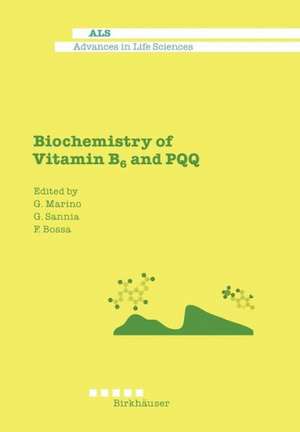Biochemistry of Vitamin B6 and PQQ: Advances in Life Sciences
Editat de G. Marino, G. Sannia, F. Bossaen Limba Engleză Paperback – 24 mai 2012
Din seria Advances in Life Sciences
- 15%
 Preț: 646.11 lei
Preț: 646.11 lei - 15%
 Preț: 645.96 lei
Preț: 645.96 lei - 15%
 Preț: 650.86 lei
Preț: 650.86 lei - 5%
 Preț: 365.99 lei
Preț: 365.99 lei -
 Preț: 417.02 lei
Preț: 417.02 lei -
 Preț: 394.51 lei
Preț: 394.51 lei -
 Preț: 387.20 lei
Preț: 387.20 lei -
 Preț: 391.02 lei
Preț: 391.02 lei -
 Preț: 405.87 lei
Preț: 405.87 lei -
 Preț: 389.70 lei
Preț: 389.70 lei -
 Preț: 400.26 lei
Preț: 400.26 lei -
 Preț: 399.88 lei
Preț: 399.88 lei -
 Preț: 398.15 lei
Preț: 398.15 lei -
 Preț: 409.69 lei
Preț: 409.69 lei -
 Preț: 395.47 lei
Preț: 395.47 lei -
 Preț: 390.25 lei
Preț: 390.25 lei -
 Preț: 382.95 lei
Preț: 382.95 lei -
 Preț: 387.38 lei
Preț: 387.38 lei - 15%
 Preț: 647.59 lei
Preț: 647.59 lei
Preț: 396.62 lei
Nou
Puncte Express: 595
Preț estimativ în valută:
75.91€ • 78.95$ • 63.62£
75.91€ • 78.95$ • 63.62£
Carte tipărită la comandă
Livrare economică 14-28 martie
Preluare comenzi: 021 569.72.76
Specificații
ISBN-13: 9783034873956
ISBN-10: 3034873956
Pagini: 388
Ilustrații: XVII, 366 p. 61 illus.
Dimensiuni: 170 x 244 x 20 mm
Greutate: 0.62 kg
Ediția:Softcover reprint of the original 1st ed. 1994
Editura: Birkhäuser Basel
Colecția Birkhäuser
Seria Advances in Life Sciences
Locul publicării:Basel, Switzerland
ISBN-10: 3034873956
Pagini: 388
Ilustrații: XVII, 366 p. 61 illus.
Dimensiuni: 170 x 244 x 20 mm
Greutate: 0.62 kg
Ediția:Softcover reprint of the original 1st ed. 1994
Editura: Birkhäuser Basel
Colecția Birkhäuser
Seria Advances in Life Sciences
Locul publicării:Basel, Switzerland
Public țintă
ResearchCuprins
History of Vitamin B6.- Molecular evolution.- Molecular evolution of pyridoxal-5’-phosphate-dependent enzymes.- Stereospecificity of aminotransferases for C-4’ hydrogen transfer and enzyme evolution.- Detection of weak structural similarities among PLP dependent enzymes.- Aminotransferases.- Crystallographic studies on the Vitamin B6-assisted enzymic transamination reaction.- Redesign of aspartate aminotransferase specificity to that of tyrosine aminotransferase.- Enzyme-substrate interactions modulating protonation and tautomerization states of the aldimines of pyridoxal enzymes.- Functional role of the mobile stretch G1y36-Va137-Gly38 of porcine cytosolic aspartate aminotransferase.- Using 1H- and 15N-NMR spectroscopy to observe active sites of porcine cytosolic and Escherichia coli aspartate aminotransferases.- Aspartate aminotransferases like it hot.- Studies on the mechanism of action of D-amino acid transaminase.- Cytosolic factors and the twisting path from birth to berth in aspartate aminotransferases.- Mitochondrial protein import: Role of certain domains of mitochondrial aspartate aminotransferase.- Cytosolic aspartate aminotransferase: Tissue-specific hormonal regulation of a housekeeping gene promoter.- Regulation by glucagon of serine: pyruvate/alanine:glyoxylate aminotransferase gene expression in cultured hepatocytes.- Glutamate 1-semialdehyde aminotransferase, a unique enzyme in chlorophyll biosynthesis.- Mechanism of glutamate semialdehyde aminotransferase probed with substrate analogues.- Tryptophan-synthase and decarboxylases.- Crystallographic and kinetic studies of the tryptophan synthase ?2?2 complex with a mutation in ? subunit lysine-87 that binds pyridoxal phosphate.- The roles of chemical transformation, loop closure, tunnel function andmetal ion activation in the tryptophan synthase mechanism.- Effects of monovalent cations on functional properties of the tryptophan synthase ?2?2 complex in solution and in the crystal.- The long-range effect on the mutual activation of the a and ? subunits in the ?2?2 complex of tryptophan synthase.- X-ray structure, sequence and solution properties of ornithine decarboxylase from Lactobacillus 30a.- Dialkylglycine decarboxylase structure: Alkali metal binding sites and bifunctional active site.- The location and role of active-site bases in PLP-dependent decarboxylase enzymes as deduced from stereochemical and kinetic studies.- GuCl-induced unfolding of pig kidney dopa decarbocylase: Evidence for a multistate process.- Phosphorylases.- The transition state complex in the phosphorylase catalyzed reaction.- Binding mode of glucans to ?-glucan phosphorylase isozymes and their chimeric enzymes.- Slow conformational transitions of muscle glycogen phosphorylase b.- Other pyridoxal-dependent enzymes.- X-ray study of tryptophanase at 2.1 Å resolution.- Crystallographic studies of tyrosine phenol-lyase.- Studies of the mechanism of tyrosine phenol-lyase: Kinetics and site-directed mutagenesis.- The role of pyridoxal phosphate in the refolding of serine hydroxymethyltransferase.- The mechanism of O-acetylserine sulfhydrylase from Salmonella typhimurium.- Involvement of PLP in biological formation iron-sulfur clusters.- Iron-sulfur clusters as alternatives to pyridoxal-5’-phosphate in bacterial L-serine dehydratases: Cloning of the gene encoding the ?-subunit of the enzyme from Peptostreptococcus asaccharolyticus.- Phosphorescence of pyridoxal kinase at room temperature: The effects of ligands bound to the nucleotide site.- The Schiff base of pyridoxal-5’-phosphatewith ethylenediamine and ethylamine: Species in solution.- Amine oxidases.- Biological role and reactivity of TPQ containing amine oxidases.- Two distinct quinoprotein amine oxidases are functioning in Aspergillus niger.- The catalytic competence of cobalt-time oxidase.- Mechanistic studies of copper/topa amine oxidases.- Design, synthesis and evaluation of mechanism-based inhibitors of copper amine oxidases.- Copper ion-dependent biogenesis of topa quinone cofactor covalently bound to bacterial monoamine oxidase.- Modulation of lysyl oxidase activity toward peptidyl lysine by vicinal dicarboxylic amino acid residues.- Quinoprotein dehydrogenases.- The structure and function of quinoprotein dehydrogenases.- Quinoprotein oxidoreductases for the oxidation of alcohols, sugars and amines.- The ternary complex between methylamine dehydrogenase, amicyanin and cytochrome C55li.- Model studies directed toward the action of quinoprotein methanol dehydrogenase.- Molecular physiology.- Nutritional aspects of vitamin B6: Requirements, recommendations and intake.- Vitamin B6 transport and metabolism: Clues for delivery of bioactive compounds.- Vitamin B6 modulation of steroid receptor-mediated gene expression.- Molecular pathology.- Pyridoxine (vitamin B6), neurotransmitters and hypertension.- A liver enzyme, serine:pyruvate/alanine:glyoxylate aminotransferase and its mutant in a primary hyperoxaluria type I case.- Pyridoxal phosphate, GABA and seizure susceptibility.- Monoclonal antibodies to bovine brain GABA transaminase.- Effects of pyrroloquinoline quinone (PQQ) on the SLE-like (Systemic Lupus Erythematosus) disease in MRL-1pr/lpr mice.- Conclusions.










